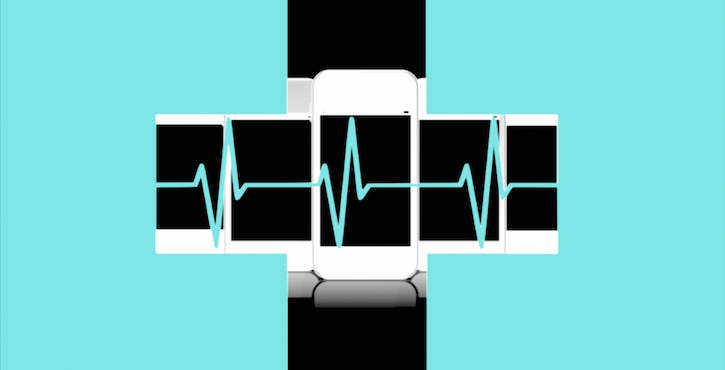How Apple's API Fits Into Its Burgeoning Healthcare Stack
One by one, the company has been adding pieces to what could be a very disruptive suite of healthcare technologies.

The smartphone, smartwatch, digital music, tablet, software, and computer giant Apple is continuing its potentially-disruptive march into the healthcare world with a newly-announced application programming interface (API) suite.
Apple hopes that the feature will help researchers and developers build health management and insight applications—and it’s a logical evolution for the company’s health offerings. If it seems like the company launches a big health-related product or functionality every year or so, it’s because it does.
>>>PODCAST: Amazon's Path of Disruption
Since the dawn of the iPhone App Store, there have been various third-party fitness trackers and health goal apps available to Apple consumers: calorie counters, quit-smoking apps, medication reminders. As early as 2009, former Apple senior vice president Scott Forstall was hinting at the allure of the medical device market—at the same event, the company announced that iOS 3.0 (yes) would be able to sync with certain specially-designed medical devices. Companies quickly built products like glucose monitors and blood pressure sleeves that could plug in and use iPhone to deliver their results.
But the company switched decisively from healthtech enabler to healthtech developer in 2014 with the launch of HealthKit (or Health). The suite was designed to give consumers the ability to monitor their fitness stats over time. While not a serious clinical intervention, it came as wearable fitness monitors were becoming increasingly integrated with smartphone and tablets. The platform was announced in that year’s WWDC at a time when rumors were swirling over the “new products” that CEO Tim Cook had hinted about to Wall Street Journal.
A few months later, it was reported that one of those new products would be Apple Watch. The device wasn’t just a wrist-worn iPhone companion: It was also a wearable in and of itself, with a heart rate monitor and a pedometer function. Released in 2015, the device quickly began to eat into the traditional wearables market, and was a natural conduit to feed health metrics into HealthKit.
Although Apple Watch took the headlines when it was announced, the company put forth another healthcare technology on the same day: ResearchKit, a platform that would allow researchers to build mobile medical studies from data obtained through HealthKit and Apple device functions like iPhone’s camera and accelerometer and Apple Watch’s heart rate monitor. And, of course, studies could use simple touchscreen-based surveys and activities.
While ResearchKit hasn’t necessarily revolutionized clinical research yet, it has generated interesting studies and global pharmaceutical companies have begun to build studies with it (retention and demographic representation remain issues).
That move was followed in 2016 by the announcement of CareKit, which allows developers to build their own health management programs and plans. One example is Corrie, a cardiac health management app built by Johns Hopkins that produced a dramatic drop in heart attack readmission rates in an early clinical study. One of the researchers on the program called it “a prescription strength app” that was “readily scalable.”
The big Apple health news in 2017 wasn’t a new product or program, but an added functionality: Subtle, but major. Apple Watch’s heart rate monitor gained the ability to send push notifications to wearers when it detected they were inactive and yet had a high heart rate, moving the device from a health metrics luxury into intervention territory. “Now, Apple Watch will notify you when it detects and elevated heart rate and you don’t appear to be active,” company COO Jeff Williams said. “Today, it is the most-used heart rate monitor in the world.”
A bit before that announcement, it became known that the company had been working with the increasingly tech-friendly FDA. The regulatory agency officially unveiled a pre-certification pilot program in September 2017 that Apple was taking part in—alongside Samsung and Fitbit, among others. The FDA said it was using feedback from the tech companies to shape its approach to digital health going forward.
And now, in 2018, Apple has made a pair of major health moves. The year began with a bang, as the company unveiled a program that would allow consumers to access their own electronic health records (EHR) remotely—an inability to do so has long been decried by patient advocates and providers. Built directly into Health, it first was available to patients of a limited number of leading health institutions. The company has been widely praised for what many see as a move that will put knowledge of their own care back in patients’ hands.
The API announced this week will sit atop that EHR access function. With the power to dredge wearable data (from HealthKit) and combine it with lifestyle information and historical health records contained in the EHR, developers will be able to build analytics and health management tools outside of the clinical (and proprietary EHR) environment—the sort of integrated, high-tech healthcare toys that industry was widely promised as it quickly digitized all of its records over the last decade.
All that’s left might be to build the EHR itself.
Related Coverage:
No, Apple Watch Can't Detect Irregular Heart Rhythms with 97% Accuracy (Yet)
Healthy Bottom Line: The Trouble With SDOH Programs and the Secret to Improving Them
September 28th 2021Several problems exist with current programs that address social determinants of health (SDOH); however, a new social model aims to combat these issues and improve the programs’ effectiveness.